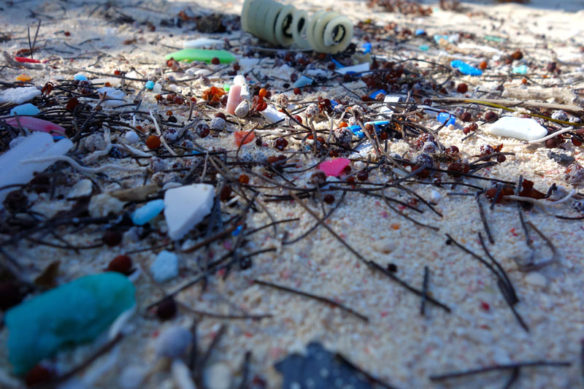
Plastic pollution. Photograph: © SAF — Coastal Care
Excerpts;
Microplastics were found at all 16 sites studied in Baynes Sound and Lambert Channel, British Columbia, and were most abundant in the sediments of Henry Bay and Metcalfe Bay, according to a new study.
The researchers found microplastics at all the sites, and identified three main types: microfibers, microbeads and micro fragments…
Read Full Article; PhysOrg (05-23-2018)
Record concentration of microplastic in Arctic sea ice; Science Daily (04-24-2018)
Experts have recently found higher amounts of microplastic in arctic sea ice than ever before. However, the majority of particles were microscopically small…
Microplastic pollution in oceans is far worse than feared, say scientists; Guardian UK (03-12-2018)
Microplastics pollute most remote and uncharted areas of the ocean; Guardian UK (02-12-2018)
The Ocean Is Contaminated by Trillions More Pieces of Plastic Than Thought, IOP Science (12-08-2015)
This new study suggests there are 15 to 51 trillion micro plastic particles (those less than 200 millimeters in size) in the world’s oceans, weighing between 93 and 236,000 metric tons. This is about seven times more than scientists had previously estimated…
More than 8. 3 billion tons of plastics made: Most has now been discarded; Science Daily (07-19-2017)
Humans have created 8.3 billion metric tons of plastics since large-scale production of the synthetic materials began in the early 1950s, and most of it now resides in landfills or the natural environment, according to a study.
Video captures moment plastic enters food chain, BBC News (03-11-2017)
A scientist has filmed the moment plastic microfibre is ingested by plankton, illustrating how the material is affecting life beneath the waves. The footage shows one way that plastic waste could be entering the marine and global food chain…
High levels of microplastics found in Northwest Atlantic fish; Science Daily (02-16-2018)
A new study finds 73 percent of mesopelagic fish caught in the Northwest Atlantic had microplastics in their stomachs, one of the highest levels globally. These fish could spread microplastic pollution throughout the marine ecosystem, by carrying microplastics from the surface down to deeper waters. They are also prey for fish eaten by humans, meaning that microplastics could indirectly contaminate our food supply…
Brain damage in fish from plastic nanoparticles in water, Science Daily (09-25-2017)
A new study shows that plastic particles in water may end up inside fish brains. The plastic can cause brain damage, which is the likely cause of behavioral disorders observed in the fish…
People may be breathing in microplastics, health expert warns; Guardian UK (05-10-2016)
People could be breathing in microparticles of plastic, according to a leading environmental health expert, with as yet unknown consequences on health…
Plastic Pollution / The Great Plastic Tide, Coastal Care ©-2009.
“The unprecedented plastic waste tide plaguing our oceans and shores, can become as limited as our chosen relationship with plastics, which involves a dramatic behavioral change on our part…”









